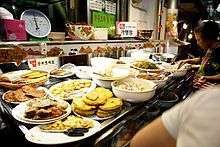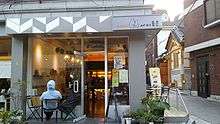Seochon
| Seochon | |
| Korean name | |
|---|---|
| Hangul | 서촌 |
| Hanja | [[wikt:|]] |
| Revised Romanization | Seochon |
| McCune–Reischauer | Sŏch'on |
Seochon (서촌) is one of the oldest neighborhoods of Jongno-gu in northern Seoul, South Korea. It may be translated as "West village" or "Western village" as it is west of the Gyeongbok Palace. It is also thought that the name could have derived from Mt Inwangsan as the mountain used to be called "Seosan" or "old mountain in the west."[1] Seochon is traditionally associated with the Joseon dynasty and Korean literature.

Boundaries[2]
Seochon is located west of the Gyeongbokgung Palace, at the base of Mt. Inwangsan. The Seoul City Wall forms a border, along with the Sajik and Jahamun subway tunnels, which were built in the late 1960s. The area is composed of fifteen smaller neighborhoods called "dong." Seochon is located at 36° 39' 25.794'' N 127° 24' 4.3848'' E with an average elevation of 33.141 m / 108.732 feet.
Culture and Traditions
Korean literature is filled with references to Seochon neighborhoods. Today the area is dotted with historical signs. While few original landmarks remain intact, it is the birthplace of King Sejong and the residence of famous authors and artists.
Traditionally, the area is of great significance to the shamanism and geomancy levels, particularly because of the influence of Inwangsan. It also includes the shrine Seoul Sajikdan, one of the founding elements of the capital, and Jongmyo, another shrine. The Gyeongbok palace is also located here.
Seochon has been long neglected compared to the wealthier Bukchon on the other side of the palace. However, it has reclaimed part of its popularity particularly following the protection of one of Seoul's largest clusters of hanok (over 600), and the renovation of landmarks to host cultural venues, such as the Yi Sang House and the Yi Sangbeom House. Pak No-soo's house in Ogin-dong was recently restored and opened as the Pak No-soo Art Museum.
Tongin Market


Located in Hyoja-dong, Tongin Market dates back to 1941 when Korea was still under Japanese rule.[3] After the Korean War in the 1950s, the region's population rapidly grew and stalls in the market became more in demand.
There are now around 70 to 90 stores,[4] including restaurants such as the popular buffet-style Lunch Cafe and a grocery store that was established for tourist convenience.
Landmarks


Sajik Park
Sajik Park was opened to public in 1922 and was first designed in the Choseon Dynasty era.[5] It was built for worshiping the gods of the Earth and harvest and has more historical features than any other park in Seoul.[6]
Tongui-dong
Tongui-dong Hanok Village is a traditional Korean village in Seochon. Once, middle-class professionals such as language interpreters and medical doctors once lived there.[7] It was the home of several famous historical figures. Painters, Yi Jung-seop and Yi Sang-beom, and poets, Yun Dongju and Yi Sang, lived there in modern times. Most of the remaining hanok are called "Gaeryang hanok", which were largely constructed after the 1910s for a government housing plan.[8]
Daelim Contemporary Art Museum
Located in the residential area of Tongui-dong, the Contemporary Art Museum is near to the historic area of the Gyeongbokgung Palace. The Daelim Museum began its concepts as Korea’s photography museum. Nowadays, it opens exhibitions that include not only photography but also design and a wide range of other art fields.[9] It is also continuing to expand into other areas.[10]
The National Palace Museum of Korea
The National Palace Museum of Korea has a large collection of art and objects from the palaces of the Choseon Dynasty era.[11] It represents the history of the Joseon Dynasty. The Museum helps to raise the public's knowledge of the artistic and cultural legacy of the Choseon Dynasty. The Museum offers various exhibitions and educational programs as well.[12]
Directions to Seochon
Take Subway Line 3 to Gyeongbokgung Station (Exit 2,3). After exiting, walk along the main road. Pass the Popeyes and continue walking for another few minutes. Turn left, just before the Woori-bank, to reach Seochon.
See also
References
- ↑ "Rediscovering Seochon". koreatimes. Retrieved 2016-02-02.
- ↑ "Latitude and Longitude Finder on Map Get Coordinates". www.latlong.net. Retrieved 2016-02-29.
- ↑ "Tongin Market (통인시장) | Official Korea Tourism Organization". english.visitkorea.or.kr. Retrieved 2016-02-02.
- ↑ "종로 엔 다 있다". 종로문화역사관광. JongNo-Gu Office. Retrieved 14 December 2015.
- ↑ "Seochon , the place where the time slows down". The UOS Times. The UOS Times. Retrieved 14 December 2015.
- ↑ "Seochon". Seoul Section. Retrieved 14 December 2015.
- ↑ "One of the oldest neighborhoods in Seoul- Seochon Village". TRAZY.COM. Retrieved 14 December 2015.
- ↑ "Rediscovering Seochon". The Korea tomes. Retrieved 14 December 2015.
- ↑ "Seochon: Aromatic Alleyways in the West". Visit Korea. KOREA TOURISM ORGANIZATION. Retrieved 14 December 2015.
- ↑ "Traditional Culture Tour: Seochon Hanok Village (Hyoja-dong – Tongui-dong)". Visit Seoul. Seoul Metropolitan Government. Retrieved 14 December 2015.
- ↑ "Walking to the Seoul's oldest neighbourhood, Seochon Fair Travel". Seochon, one of the oldest villages in Seoul. PlayPlanet. Retrieved 14 December 2015.
- ↑ "The Secret Journey to Seochon". The SookmyungTimes. Retrieved 14 December 2015.